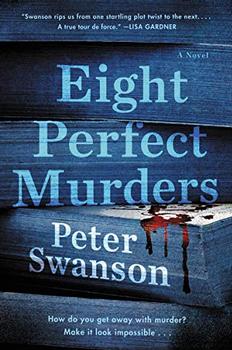Summary | Excerpt | Reviews | Beyond the Book | Read-Alikes | Genres & Themes | Author Bio

This article relates to Eight Perfect Murders
 In Eight Perfect Murders, bookseller Malcolm Kershaw is contacted by the FBI regarding his list of favorite mystery novels with seemingly unsolvable murders. The oldest book on Malcolm's list is The Red House Mystery, written in 1922 by A.A. Milne (of Winnie-the-Pooh fame). Milne's book is a locked room mystery, also known as an impossible crime mystery, featuring a man who is murdered in a literal locked room, though the genre extends to more expansive locations as well, such as the island in Agatha Christie's And Then There Were None. What all books in the genre have in common is that the crime seems impossible, and thus equally impossible to solve, although, of course, it is solved in the end. Locked room mysteries are less about the "who" of the crime and more about the "how." If the person was alone in a locked room, how could they have been murdered? If the object was kept safe in a locked room with only one key, how could it have been stolen? If everyone trapped on the island has a solid alibi, who could the killer be?
In Eight Perfect Murders, bookseller Malcolm Kershaw is contacted by the FBI regarding his list of favorite mystery novels with seemingly unsolvable murders. The oldest book on Malcolm's list is The Red House Mystery, written in 1922 by A.A. Milne (of Winnie-the-Pooh fame). Milne's book is a locked room mystery, also known as an impossible crime mystery, featuring a man who is murdered in a literal locked room, though the genre extends to more expansive locations as well, such as the island in Agatha Christie's And Then There Were None. What all books in the genre have in common is that the crime seems impossible, and thus equally impossible to solve, although, of course, it is solved in the end. Locked room mysteries are less about the "who" of the crime and more about the "how." If the person was alone in a locked room, how could they have been murdered? If the object was kept safe in a locked room with only one key, how could it have been stolen? If everyone trapped on the island has a solid alibi, who could the killer be?
This trope has been popular in the mystery genre for more than a century. Edgar Allen Poe is often regarded as the first to have written a locked room mystery, with his 1841 short story "The Murders in the Rue Morgue," which features a woman murdered in her locked apartment and shoved into the chimney. However, detective novelist John Dickson Carr is considered the master of this subgenre. In 1981, honored mystery writer Edward D. Hoch invited 17 well-known authors and reviewers of detective fiction to vote on the best locked room mystery for the introduction of a new anthology. Carr's 1935 novel The Three Coffins (published in the UK as The Hollow Man) was chosen as number one. Interestingly, Carr himself had once said that he considered French author Gaston Leroux's The Mystery of the Yellow Room to be the best example of this type of mystery, but Leroux's work came in third in the 1981 rankings.
Other popular examples from the 19th and 20th centuries include Arthur Conan Doyle's The Adventure of the Speckled Band (1892), Agatha Christie's Murder on the Orient Express (1934) and her 1939 classic, And Then There Were None. Also, The King is Dead (1952) by Frederic Dannay and Manfred Bennington Lee (published under the pseudonym Ellery Queen). Incidentally, And Then There Were None was the only pre-21st century title to make it onto one of BookBrowse's All-Time Top 10 Book Club lists, coming in at #9 in the Mysteries and Thrillers category.
The solutions to many older locked room mysteries seem quite far-fetched today, but there are a number of newer titles that have introduced more complex solutions to contemporary audiences. These include The Woman in Cabin 10 and In a Dark, Dark Wood by Ruth Ware, The Hunting Party by Lucy Foley, Shutter Island by Dennis Lehane, Guess Who by Chris McGeorge, and In the Morning I'll Be Gone by Adrian McKinty. Translations of many foreign locked room mysteries have also become available in recent years, introducing books such as The Tokyo Zodiac Murders by Soji Shamada and Stieg Larsson's The Girl with the Dragon Tattoo to English audiences. Locked room mysteries have also appeared on the screen. Jonathan Lynn's Clue (1985) and Rian Johnson's Knives Out (2019) both feature a locked house mystery, while a number of detective and crime television shows have featured locked room episodes, including BBC's Sherlock, Citytv's Murdoch Mysteries, and USA Network's Monk. This style of mystery also provided the premise for CBS's Harper's Island, which, much like And Then There Were None, featured a group of guests on an island being murdered one by one.
The locked room construct has maintained its popularity over the past century and a half largely due to the seemingly impossible nature of the crimes. Although the solutions have grown more sophisticated as society has advanced and new crime-solving techniques have been developed, at their heart, these mysteries still speak to the human desire for knowledge and the frustration of leaving things unknown.
Filed under Reading Lists
![]() This "beyond the book article" relates to Eight Perfect Murders. It originally ran in March 2020 and has been updated for the
January 2021 paperback edition.
Go to magazine.
This "beyond the book article" relates to Eight Perfect Murders. It originally ran in March 2020 and has been updated for the
January 2021 paperback edition.
Go to magazine.
Your guide toexceptional books
BookBrowse seeks out and recommends the best in contemporary fiction and nonfiction—books that not only engage and entertain but also deepen our understanding of ourselves and the world around us.